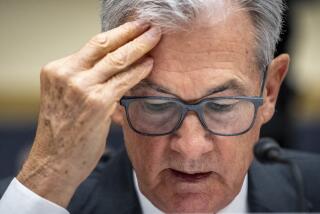Powell says Fed ‘well positioned’ for the ‘risks and uncertainties’ that lie ahead

- Share via
WASHINGTON — The Federal Reserve is prepared to keep its key interest rate unchanged for now as inflation remains elevated and the job market is solid, Chair Jerome H. Powell said Tuesday on the first of a two-day appearance before Congress.
After cutting its key rate a full percentage point in the final three months of last year, with “the economy remaining strong, we do not need to be in a hurry to adjust our policy stance,” Powell said in written remarks to the Senate Banking Committee.
Powell’s appearance comes with inflation still above the Fed’s 2% target and the Trump administration is upending many longtime U.S. policies by imposing tariffs on steel and aluminum and seeking to cut government spending drastically. President Trump has frequently attacked the Fed in the past, raising concerns about the central bank’s historic independence from politics.
Powell was quickly thrust into the partisan turmoil surrounding Trump’s flurry of executive orders and the efforts of billionaire Elon Musk, through the Department of Government Efficiency, to slash government programs.
Sen. Elizabeth Warren (D-Mass.) urged Powell to maintain the Fed’s support for the Consumer Financial Protection Bureau, a consumer protection agency that was essentially shut down over the weekend when the Trump administration ordered officials at the bureau to stop work and closed the building for a week. The CFPB gets its funding from the Fed.
“Do not make the Federal Reserve an accomplice to this illegal act, and forever sully the reputation of the Fed,” Warren said.
Sen. Tim Scott (R-S.C.), chair of the committee, criticized banking regulators, including the Fed, for the alleged “debanking” of cryptocurrency firms and individuals in the industry. Debanking occurs when banks shut down customer accounts because they believe they pose financial, legal or reputational risks to the banks.
Scott charged that debanking has occurred for political reasons, echoing claims by venture capitalist Marc Andreesen and others.
Powell said that it was “fair to take a fresh look at debanking.”
Powell did not mention Trump’s tariffs and other policy changes in his statement, but said that the Fed is “well positioned to deal with the risks and uncertainties that we face.”
The Fed chair also said the central bank has launched a second review of its policy strategies and its communications tools. Powell reiterated that the review would not focus on whether to change its 2% inflation target, which some economists argue is too low. Powell has repeatedly said that the Fed shouldn’t change the target while it is still struggling to get inflation down to 2%.
After the Fed’s last policy review in 2019, it said it would seek inflation that averaged 2% over time. Some economists have argued that the change led the Fed to react too slowly to the inflation spike in 2021 and 2022. The Fed didn’t begin raising its key interest rate until March 2022. Rate hikes are intended to slow borrowing and spending to cool inflation.
Last week, comments by many Fed officials — as well as a decline in the unemployment rate — suggested the odds of a rate cut anytime soon have dwindled.
While Fed officials penciled in two rate cuts this year at their December meeting, economists and Wall Street investors are increasingly skeptical, with some predicting no reductions at all in 2025. On Friday, economists at Morgan Stanley said they now expect just one rate cut this year, and investors also expect just one — in July — according to pricing in futures markets.
Fewer cuts could translate into a longer period of elevated mortgage rates and high costs to borrow money for everything from automobiles to credit cards. Still, mortgage rates are closely tied to the yield on the 10-year Treasury note, which can move independently of the Fed’s actions.
Last Friday, Fed governor Adriana Kugler said that the labor market was “stable” and that “gives us a little bit of time to make some decisions.”
She added that potential policy changes from the Trump administration have added uncertainty to the outlook for the economy. Economists have said that widespread tariffs, and the deportation of immigrants that Trump has also promised, could push up inflation. Others argue that Trump’s deregulatory policies could, by increasing supply, reduce prices.
“The cautious and the prudent step is to hold the [Fed’s key] rate where it is for some time,” Kugler said.
The government said last Friday that employers added a solid number of jobs last month while the unemployment rate ticked down for the second straight month to 4%, historically quite low. Hiring in November and December was revised much higher.
Steady hiring and a mostly healthy job market suggest that there is less of an urgent need for the Fed to reduce borrowing rates. It implemented a steep half-point cut in September after weak hiring over the summer spurred fears that the economy was stumbling, possibly into recession.
The jobs report “bolsters our confidence that the Fed cutting cycle is over,” economists at Bank of America wrote in a note Friday.
Rugaber writes for the Associated Press.
More to Read
Inside the business of entertainment
The Wide Shot brings you news, analysis and insights on everything from streaming wars to production — and what it all means for the future.
You may occasionally receive promotional content from the Los Angeles Times.










